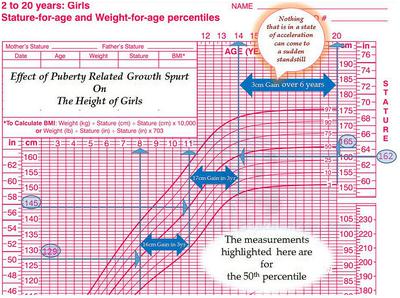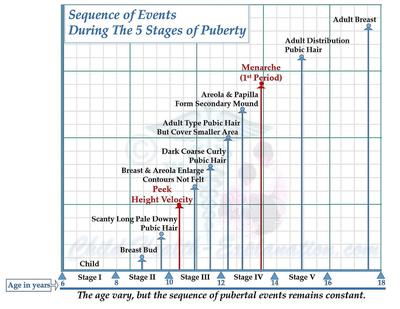Falling off Her Growth Curve?
Rule out PCOD in Teenage Girls
by Louanne
(France)

Effect of Puberty Related Growth Spurt On The Height of Girls
My daughter’s puberty related growth spurt has probably failed. She was found to be 1cm below her growth curve when she got the first menstrual period at 12yr 3mth of age. She was 155cm tall then.
Since then I have noticed a constant downward shift on her percentile growth chart for height. If she would have remained on her primary curve, she would be 165cm at the age of 15. Even so her doctor said it is ok, because this can happen to be a bit below or above the line.
Over next 1 year she gained only 2cm. Thus at 13, she was 157cm tall, and 2cm below her curve. Yet the doctor said, “don't worry. There will be a second surge. She will come back to her growth curve.” Well, I believed him.
Until a few months ago I have noticed that her friends of the same age have started to grow taller than her. But they all are late bloomers. Nonetheless, something is not ok with my daughter. She is 14 years and 2 months now.
I scheduled another visit yesterday. She measured only 159 cm, which is 3 - 4 cm below her curve. She had again gained only 2 cm height in one year. The doctor said, “she is not 15 yet. She will grow more, and reach where she is supposed to be.....”
165 cm? That is 6 cm in next 1 year?
For me, this will only come with a miracle if no action is taken!
My question is, I have been waiting for the second surge. But from what I have gathered from the internet this is not possible after the first period.
Please could you help me?
Is everything ok with my daughter?
Will she really be able to reach her potential height of 165 cm in one or two years?
I am really depressed. I’m blaming myself to have believed the doctor. I never doubted him, and so I took no action for two years. I feel guilty. Perhaps it's me who did not give her enough nutrition that she needed to grow to her full potential. I am 165cm tall and my husband is 175.
Thank you.
Waiting for your reply,
Wannee
The Expert, Ren Chats Answers
Most girls do continue to gain height for about 5 years after the menarche, but at much lower a pace - see the graph given above.
Growth acceleration during early and mid teens coincides with puberty. It lasts for about 5 years. It is the outcome of the sudden surge of sex hormones and associated intricate changes in the growth promoting hormones. Catch up growth for teenage development is therefore not known. However, acute nutritional deprivation caused by sickness or otherwise, would be followed by catch up growth on recovery. In such cases the effect on the growth graph will be seen more as poor weight gain rather than the loss of height gain. Short stature due to deprivation occurs only in extreme cases.
Since you have not touched the issue of body weight, I do not expect any downward trend on the weight graph of your daughter. On the contrary with expected normal weight gain, her growth chart should be now showing some discrepancy in the height and weight percentiles.
One of the common cause of weight-height percentile discrepancy that surfaces during teens is PCOD, Poly Cystic Ovarian Disease. Unfortunately it is quite easily confused for the normal increase in body fat deposition in girls during the peri-pubertal years.
Premature pubarche (between 6 -8 years of age with No height acceleration or advancement in the bone age) is its earliest tell-tale sign, which too is missed both by the parents and the doctors.
Normally the pubic hair appear about 8 months after the development of breast buds, which may occurs any time after 8½ years, approximate average age being 11. This phase is also marked by the acceleration of height gain, the peak of which reaches soon after stage II of SMR (Sexual Maturity Rating) – see the illustration given above.
Rapid growth phase starts after the appearance of breast buds, and continues till menarche sets in. Thereafter the height gain gradually falls. As a result only about one tenth of the total height gain credited to puberty (20-25% of final adult height) occurs during the teen years that follow the first period. The age of onset and progression of puberty varies, but this sequence of pubertal events remain constant.
It is well known that 10-15% of girls develop pubic hair before 8 years of age without any sign of height acceleration or bone age advancement. This is attributed to rise in adrenal androgen secretion during sexual maturation. It is the androgenic effect of this hormone that gives rise to pubic and underarm hair growth. Normally the underarm hair become noticeable around menarche. Early exaggerated androgen secretion results in hair growth (pubic or underarm, or both) around the seventh year of life, and at a later date functional ovarian hyperandrogenism, insulin resistance, and polycystic ovarian syndrome.
Known since 1935, PCOD affects more than 15 – 20% young women, still in many the diagnosis is missed until mid-twenties. This is because the early clues, such as irregular periods, unwanted hair growth, weight gain and acne, are confused for usual troubles of teenage due to yet maturing hormonal cycles. The brief positive effect of rising androgens on the height of the child during prepubertal years gets ignored and forgotten. More so because, despite the corresponding acceleration in bone maturation, the final height of the child is negligibly affected. Its effect on the onset and progression of puberty is also hardly noticeable.
To be precise, the diagnostic criteria for PCOD are obscure.
Clinical presentation is confusing. Specific diagnostic test are lacking. And the awareness of the disorder is poor. Therefore the delay in diagnosis can be prevented only by drawing clinician’s attention to the clues mentioned. A good clinical history and examination, along with a few laboratory tests should help clinch the diagnosis, and exclude other entities that may present in much the same way.
It is important to rule out the possibility of PCOD in teenage years. Missed cases suffer emotional and physical issues during the tender formative years. Irregular heavy periods, abnormal weight gain, excessive facial and body hair, and acne cause severe embarrassment. Depression and anxiety jeopardise their social and academic progress. Some even land up with psychologist.
Liked what you read just now? Pay it forward!












